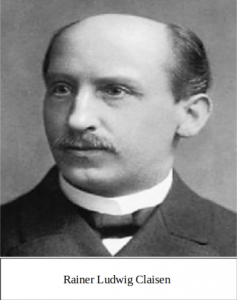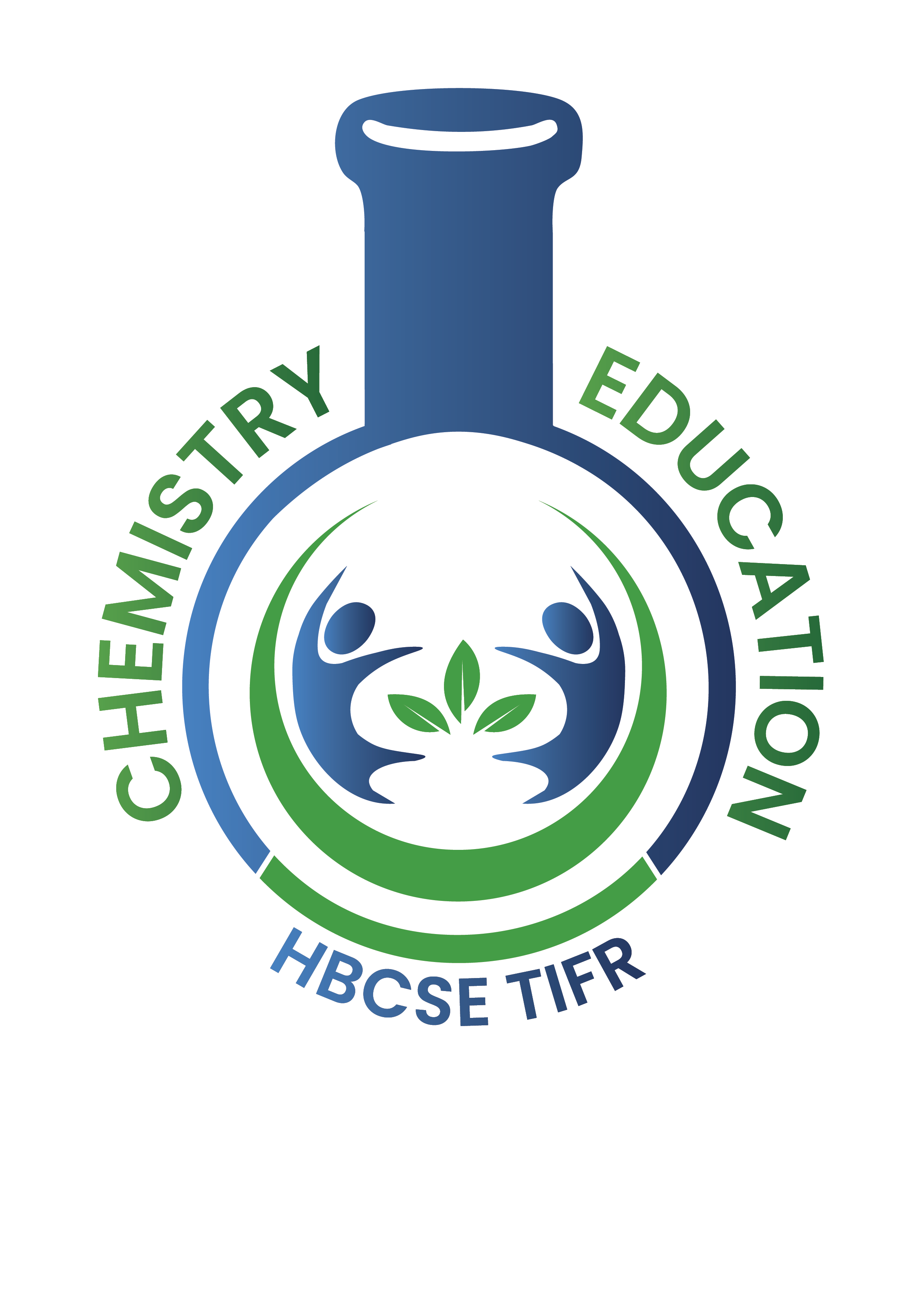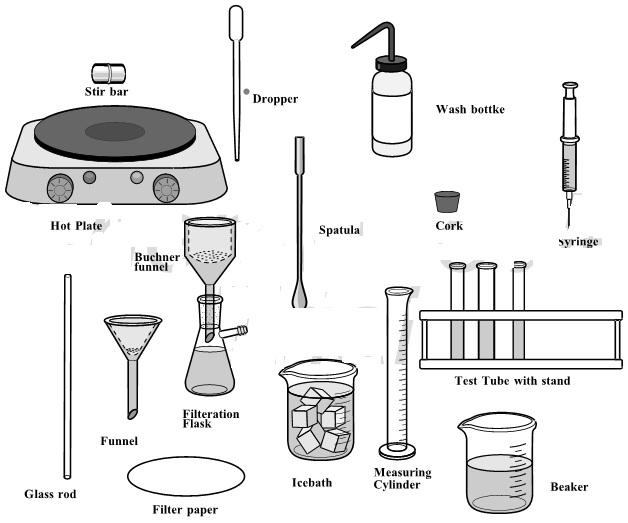Aldol condensation is an important route of organic synthesis because it provides an efficient way to form carbon-carbon bond. In this condensation an enol or enolate ion reacts with a carbonyl compound to form a β-hydroxyketone or β-hydroxyaldehyde which is then followed by dehydration. The reaction is commonly implemented to manufacture solvents, such as isophorone, used in printing inks, lacquers, adhesives, and diacetone alcohol, used in making artificial silk and leather.

It is also used in the manufacture of α, β unsaturated ketones and aromatic ketones known as chalcones. This condensation is generally used to create plasticizers which are used to convert rigid plastic polyvinyl chloride into a soft, flexible and elastic material. This experiment utilizes the above condensation reaction as a means for preparing dibenzalacetone (1,5-Diphenylpenta-1,4-dien-3-one), first prepared in 1881 by German chemist, Rainer Ludwig Claisen and Swiss chemist, Charles-Claude-Alexandre Claparède. Dibenzalacetone is a pale yellow crystalline solid often used as a ligand in preparing organometallic complexes used as catalysts in coupling reactions, It is also a common ingredient in some sunscreens as it absorbs the harmful UV light. Moreover, it does not cause an allergic reaction on a person’s skin.
An important step for obtaining high yield in any synthesis is ensuring purity of starting materials. Many of the organic compounds are found as mixtures and need separation. One of the common techniques used to separate a pure compound from a mixture is solvent extraction. Solvent extraction involves separation of compounds based on their relative solubilities in two different immiscible liquids. It is widely used in the production of fine organic compounds, processing of perfumes, production of vegetable oil and biodiesel, etc.
This experiment tries to capture the essential process steps one encounters during an actual organic synthesis for production. Thus the experiment has four subparts. First part requires identification of functional groups present in the reactants, compound A and B using the supplied reagents. This is then followed by separation of a mixture of compound A and B using solvent extraction method. After isolating the two compounds and regenerating them quantitatively, you will carry out the base catalyzed aldol condensation reaction with one of the compound.
Once you finish with the synthesis, you will perform TLC (Thin Layer Chromatography) to check the purity of the product synthesized by you.
Doing this experiment carefully and developing skills in the processes involved can help you understand how to carry out chemical synthesis to obtain pure products while starting with impure (and sometimes unknown) starting materials.
Prerequisite:Theory
Identification functional group.
Qualitative separation analysis
Aldol reactions conditions and important parameters
Stoichiometric calculations involved in organic reactions
Techniques
Quantitative separation of components in a mixture
Slow addition of one solution to another with stirring
Filtration of product using suction
Thin Layer Chromatorgraphy (A-guide-to-thin-layer-chromatography-technique)
Reference
- DIBENZALACETONE. (1932). Organic Syntheses, 12, 22. https://doi.org/10.15227/orgsyn.012.0022
- [PDF] Optimization of the Aldol Condensation Yield of Dibenzalacetone – Free Download PDF. (2008). NANOPDF. https://nanopdf.com/download/optimization-of-the-aldol-condensation-yield-of-dibenzalacetone_pdf
- Jeffery, G. H., Bassett, J., Mendham, J., & Denney, R. C. (1989). Vogel’s Textbook of Quantitative Chemical Analysis (5th ed.). John Wiley & Sons Inc.
- Rainer Ludwig Claisen. (1897). [Photograph]. Wikimedia Commons. https://en.wikipedia.org/wiki/Rainer_Ludwig_Claisen#/media/File:Ludwig_Claisen_1897_Kiel.jpg
Part I: Identification of functional groups in compounds A and B
Glassware
| ▪ Droppers | 4 |
| ▪ Cavity plate | 1 |
Chemicals
| ▪ Compound A and B | |
| ▪ Sat. NaHCO3 | |
| ▪ 10% aq. NaOH | |
| ▪ Neutral FeCl3 solution |
| ▪ Aq. KMnO4 | |
| ▪ Ammoniacal solution of AgNO3 |
Part II: Separation of the Given Mixture of Compounds A and B
Glassware
| ▪ Beakers | 2 |
| ▪ Dropper (plastic) | 2 |
| ▪ Filter paper (circles) | 1 |
| ▪ Funnel | 1 |
| ▪ Glass rod | 1 |
| ▪ Measuring cylinder (10mL) (25 mL) | 2 1 |
| ▪ Syringe (2 mL) | 1 |
| ▪ Wash Bottle | 1 |
Chemicals
| ▪ Sat NaHCO3, 30 mL | |
| ▪ 1:1 HCl, 15 mL | |
| ▪ pH paper | |
| ▪ Mixture of Compound A and B |
Part III: Preparation of Derivative
Glassware
| ▪ Conical Flask | 2 |
| ▪ Cork | 1 |
| ▪ Filter paper (circle) | 1 |
| ▪ Funnel | 1 |
| ▪ Glass rod | 1 |
| ▪ Ice bath | 1 |
| ▪ Measuring cylinder (50 mL) (10mL) | 1 1 |
| ▪ Syringe (1 mL) | 1 |
| ▪ Wash Bottle | 1 |
Chemicals
| ▪ Acetone, 5 mL | |
| ▪ Ethanol, 30 mL | |
| ▪ NaOH, 35 mL |
Part IV: TLC
Glassware
| ▪ Beaker | 1 |
| ▪ Fusion Tubes | 2 |
| ▪ Capillary | 2 |
| ▪ TLC plate | 1 |
| ▪ Watch glass | 1 |
Chemicals
| ▪ Pet Ether and Chloroform mixture (90:10) | |
| ▪ (solvent system for TLC) | |
| ▪ Acetone (solvent for dissolution of sample) |
Hazard Symbols
Corrosive to skin ![]()
Oxidizing ![]()
Toxic ![]()
Irritant ![]()
Harmful to environment ![]()
Flammable ![]()
Organic qualitative analysis, separation of compounds and preparation of derivative
Chalcones are 1,3-diphenyl-2-propene-1-one, in which two aromatic rings are linked by an aliphatic three carbon chain. These are found in edible plants and are considered to be important in various biological compounds. It is also of great importance in pharmaceutical industry as a variety of novel heterocyclics can be designed.
Chalcones are generally coloured compounds because of the presence of the chromophore -CO-CH=CH-, which depends in the presence of other auxochromes. Chalcones and their derivatives are known for their anti-diabetic, anti-inflammatory, anti-parasitic, anti-histaminic, anti-malarial, anti-oxidant, anti-fungal properties.
The current experiment tests the student on various aspects of organic chemistry, such as functional group analysis, separation of two compounds and their regeneration, synthesis and thin layer chromatography. Some of the skills are known to the students and some skills are learnt in the process of carrying out the experiment. The students are also asked to check the purity of the product synthesized using TLC technique.
Part I
You are expected to complete Part I of this task in the first 30 minutes and return the paper to the laboratory expert. At the end of this part, you will be given the paper for part II.
Part I: Identification of functional groups in compounds A and B
You are given two compounds Compound A (molecular mass 122) and Compound B (molecular mass 106). Following reagents are given to you: Sat. NaHCO3, 10% aq. NaOH, neutral FeCl3 solution, aq. KMnO4, ammoniacal solution of AgNO3.
Conduct appropriate tests with the reagents provided to you and identify the functional groups present in compound A and B. Write your observations in the following table.
Compound A
| Test | Observation | Functional Group Present |
|---|---|---|
Compound B
| Test | Observation | Functional Group Present |
|---|---|---|
Part II: Separation of the Given Mixture of Compounds A and B
A mixture of compounds A and B is supplied to you in a 100 mL beaker. Add 20 mL of saturated NaHCO3 solution to this mixture and stir the solution for 5 minutes (till effervescence ceases). Carefully, transfer the contents of the beaker to 25 mL measuring cylinder supplied to you. Use another 5 mL of saturated NaHCO3 to transfer the content completely. Allow the two layers to separate clearly. Remove the organic layer, with the help of a syringe and transfer it to a clean 10 mL measuring cylinder. Note the volume of the organic layer (compound B). You will be using this layer for the preparation of new compound (see Part III).
Volume of the organic layer (compound B)…………………mL
Regeneration of compound A from the aqueous extract
Transfer the aqueous layer from the measuring cylinder to a 100 mL beaker. Add 50% HCl solution in small lots to the beaker with stirring till the solution is distinctly acidic (use pH paper). Note the volume of HCl added. Filter the precipitate (compound A) through filter paper. Use minimum amount of water for transferring and washing of the precipitate. The expert will collect your compound for drying.
Volume of acid needed for regeneration of compound A:…………….mL
The organic layer obtained in part II above (in the measuring cylinder) contains compound B, that is, benzaldehyde. You will be preparing dibenzalacetone from benzaldehyde. The reaction is presented below:

The density of benzaldehyde = 1.04 g cm–3 and that of acetone = 0.787 g cm–3.
Using the reaction given above and the density data, calculate the volume of acetone needed to be added for the preparation.
Volume of acetone needed for derivative preparation:…………………mL
Part III: Preparation of Dibenzalacetone from benzaldehyde
To the organic layer in measuring cylinder, add the volume of acetone calculated by you with the help of a syringe supplied to you (Keep the tip of the needle of the syringe immersed in the organic layer while adding the acetone). Add 3 mL of ethyl alcohol to the same flask. In another conical flask, take 30 mL of 10 % NaOH and add 24 mL of ethanol to it. Stir the contents and keep the flask in ice bath for 5 minutes. With help of a syringe (used for transferring organic layer in part II), add half the quantity of benzaldehyde-acetone-ethanol mixture. Keep shaking the flask intermittently for about 15 minutes, without removing it from the ice bath. After this, transfer the remaining portion of benzaldehyde-acetone-ethanol mixture. Keep shaking the flask intermittently for another 15 minutes. Filter the product using suction filtration and wash it with 50 mL of water.
Part IV: TLC
Procedure for TLC
Dissolve a drop of benzaldehyde in a small quantity of acetone in a sodium fusion tube. Similarly prepare a solution of your product. Obtain a TLC plate from a laboratory expert. Draw a faint line, at a distance of about 1cm from the edge of the plate. Using a thin capillary tube, place a drop of the benzaldehyde solution on the line drawn on the plate. Allow it to dry. Then in a similar manner, spot the product solution on the same plate. Take care that the two spots do not merge into one another. Allow this spot also to dry. Then place the plate in the beaker, containing the eluent (supplied to you). Cover the beaker with a watch glass, and allow the solvent to rise appreciably (approximately 1 cm away from the top). Remove the plate from the beaker and mark the solvent front immediately. Mark the spots after exposing the plate to UV light (laboratory expert will help you for UV chamber). Calculate the Rf values using the formula given below and record the results.
a) Rf of benzaldehyde:
b) Rf of dibenzalacetone:
Part II
Mass of the empty butter paper:………………..g
Mass of butter paper + compound A:………….g
Mass of compound A:……………g
Part III
Mass of the empty butter paper……………g
Mass of butter paper + dibenzalacetone………….g
Mass of dibenzalacetone………………..g
(a) Colour of dibenzalacetone……………….
(b) Appearance (tick the correct option)
Crystalline ……… Amorphous…………
Calculate:
(a) Theoretical yield on the basis of the mass of benzaldehyde
(b) The yield obtained as a percentage of theoretical yield.
Why is the reaction in Part III carried out in an alkaline medium?
This video is shot in the chemistry laboratory of HBCSE and can be used for educational purposes


